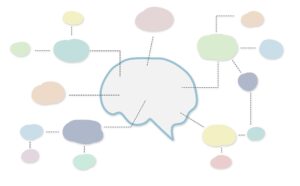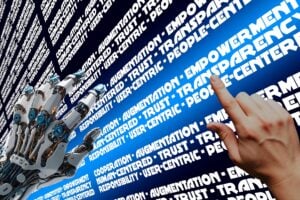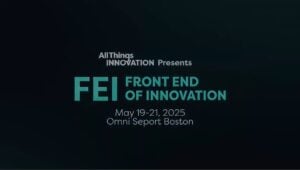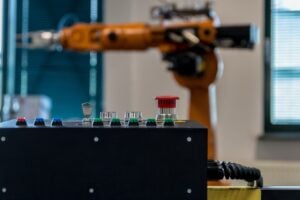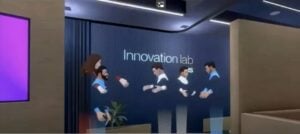AI as Thinking Partner
So just what might the future hold for the corporate innovator? For Prapti Jha, Innovation Strategist, We Speak Innovation, she sees AI as having a broad influence. In some ways, this is about communicating innovation more easily and effectively to others. Can anyone now be an innovator?
Jha observes, “One of the biggest shifts that I see coming is because of this generative AI boom, we all can learn something about a field that was totally a black box for us. And innovation is a part of it. People from other fields can also learn a little bit about innovation easily, pretty much as compared to the time it would take them earlier. The same goes for the innovators for other fields like manufacturing or any other field that might feel like a closed box to us.”
“We all have that access to information in a much more digestible way,” says Jha. “This leads eventually to a world, a corporate setting, where we’ll have an intra-collaborative, interdisciplinary setting—basically all the different disciplines working together. This is something that innovators have always pushed towards to break the silos of the corporate world. But I see it happening even more with AI. This is happening in other fields as well, such as coding, where other people can now jump into that field and create that output.”
Surely, the discipline of innovation is more complex than just coding yet Jha makes the point that AI is flattening the landscape, and making it more accessible for all.
Jha says, “That leads us to the future, where there will be more interdisciplinary kinds of organizations. All of these functions will be more connected to each other and also at times overlapping with each other. I’m very curious to see how this would lead to actual change in organizational structures.”
“Because as innovators, we also work in the area of development and design. What would that 2030 design might look like with AI being such a huge player into our teams? Basically, AI is moving forward as a colleague that we have, and it’s making all of us much more capable of understanding something that would be hard for us to digest earlier. Again, things are moving so fast. Of course, next year, I might have more ideas about it or a different idea. But that’s what I’m thinking right now,” says Jha.
Jha brings up an interesting point of AI as a thinking partner. This could be key when exploring all of the AI solutions for innovation that are now developing in the marketplace.
Jha continues, “We need to capture the idea of how AI can be your thinking partner. How you think as a human and how can you leverage AI solutions or AI as a thinking partner is something of a mindset that we must develop. Once we have that mindset of leveraging AI for whenever we are doing a thinking job, and, of course, then also comes tangible jobs that we give AI to do for us. That gives us an opportunity to embrace all the different solutions. But that mindset, that approach, would still stay intact for a while, and that’s something that is important for us to understand and rewire our brains rather than just jumping into the solutions. If we have that approach, that mindset, that really helps us filter the things that we need and then look out for the solutions that are beneficial.”
Moving Ahead with Creative Velocity
For Leslie Grandy, Lead Executive in Residence, University of Washington – Michael G. Foster School of Business, “Generative AI can be crucial in helping overcome biases like Expert Think and organizational inertia. By possessing psychological distance from the problem and providing alternative perspectives and solutions that may not be influenced by human biases or traditional industry norms, generative AI can challenge teams to consider truly novel approaches to solving problems.”
Grandy, who is the author of Creative Velocity: Propelling Breakthrough Ideas in the Age of Generative AI, feels that AI can help teams with a wide range of collaborative tasks and creative skills.
“Any team—not just a team tasked with innovation—can partner with Generative AI through structured creative frameworks that help develop collaboration and creative thinking skills,” she says. “This means innovation can come from any role or level in an organization. Incorporating generative AI into the team’s creative processes can enhance their problem-solving abilities, accelerate innovation, and more effectively address complex customer needs. However, it’s important to view generative AI as a tool to augment human creativity rather than replace it. The most effective approach combines the analytical power and extensive knowledge base of generative AI with the nuanced understanding, empathy, and creative intuition of human product teams.”
As for what may be on the horizon, Grandy, feels it will still take a while to sort out the ethical issues and actual jobs that AI might reduce. Until then innovation awaits in any number of fields.
“I am fascinated by the conversation around artificial general intelligence,” relates Grandy. “I think this is what many people fear will be the engine for reducing enterprise human capital. It’s probably more than a decade off from realization, and it will likely take longer to sort out the ethical issues around its applications.”
She adds, “I also expect to see rapid growth in the use of digital twins across various industries, ranging from healthcare to building design and management. These ‘living models’ of complex systems can enhance everything from positive patient outcomes to building performance. Mixed-reality experiences will become more mainstream for the enterprise. While the metaverse garnered attention in popular culture, enterprise adoption of XR for training, remote collaboration, and simulations will accelerate. Penetration across verticals like consumer real estate and entertainment, along with hospitality, food services, and manufacturing, will continue to grow.”
Editor’s Note: Join us next week for part 2 of this blog, as we conclude our innovation best practices series.
Video courtesy of Plug and Play Tech Center
Contributor
-

Matthew Kramer is the Digital Editor for All Things Insights & All Things Innovation. He has over 20 years of experience working in publishing and media companies, on a variety of business-to-business publications, websites and trade shows.
View all posts














